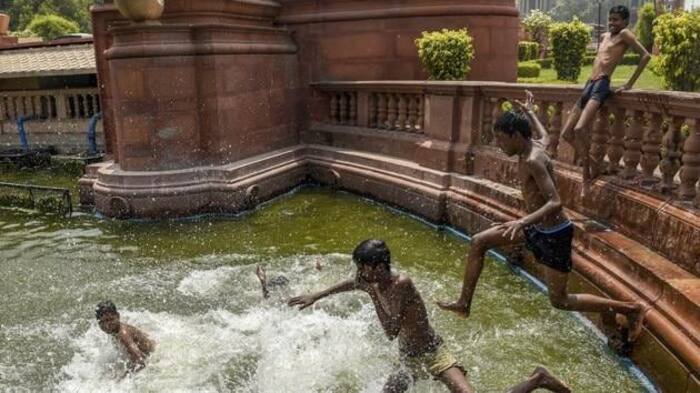
By clicking “Accept All Cookies”, you agree to the storing of cookies on your device to enhance site navigation, analyze site usage, and assist in our marketing efforts Cookies Policy.

New Delhi: Blistering heat scorched north India on Thursday driving power demand to new highs while the India Meteorological Department warned that the heatwave is likely to continue in this region for the next two days. It also said there is no chance of Delhi and its neighbouring region receiving monsoon rains till July 7. After that, the region will witness below-normal rainfall till the middle of this month.
Temperatures across the northern plains have crossed 40 degrees Celsius in the last few days. The southwest monsoon has covered the entire country but has eluded Haryana, Delhi, parts of Punjab, west Rajasthan and west Uttar Pradesh.
A number of places in the Himalayan hills have been experiencing unusually high temperatures.
Thoise in Ladakh’s Nubra Valley and Solan hill station in Himachal Pradesh recorded 31 degrees Celsius and 35.5 degrees Celsius. Drass, one of the coldest places in the country where the mercury falls below minus 20 degrees Celsius, recorded a high of 22.6 degrees Celsius.
Heatwave conditions were recorded in most places is Punjab, Haryana, Chandigarh, Delhi, west Uttar Pradesh, northwest Rajasthan and northwest Madhya Pradesh, with severe heatwave conditions at isolated areas in the region.
Severe heatwave conditions were observed at isolated places over northeast Rajasthan as well, the IMD said.
The national capital on Thursday recorded a maximum temperature of 43.1 degrees Celsius, six notches above the normal, pushing the city’s peak power demand to 7,026 MW on Thursday afternoon, the highest in this season so far.
The season’s previous peak of 6,921 MW was recorded just a day earlier on Wednesday. Delhi recorded its first heatwave of this summer on Monday with the mercury soaring to 43 degrees Celsius.
In Delhi’s neighbourhood, Gurgaon sizzled at 44.6 degrees Celsius, seven notches above the normal, as a heatwave swept Haryana and parts of Punjab.
Among other places in Haryana, Hisar recorded a high of 44 degrees Celsius, up five notches against normal, while Rohtak and Bhiwani recorded identical maximums of 44 degrees Celsius each. Narnaul also braved the hot weather at 43.5 degrees Celsius, according to the Meteorological Department here.
In Punjab, Patiala recorded a maximum temperature of 41.6 degrees Celsius, up seven notches against normal. Bathinda recorded a high of 41.5 degrees Celsius, up three degrees while Gurdaspur’s maximum settled at 40 degrees Celsius.
Chandigarh, the common capital of the two states, also reeled under the hot weather recording a high of 40.8 degrees Celsius.
With the rise in mercury, the electricity demand in Punjab has peaked at over 14,000 MW a day, forcing the state-owned power utility PSPCL to impose unscheduled power cuts and regulatory measures on the industry.
Consumers at several places held protests against the erratic power supply, and blocked roads, with the opposition parties slamming the ruling Congress for not being able to meet the demand.
The PSPCL has decided to impose power regulatory measures on industrial consumers by imposing two-day weekly offs on industry, including rolling mills, arc and induction furnaces with immediate effect. It has appealed to government and public sector offices in the state to use electricity judiciously and switch off air conditioners up to July 3.
“Heatwave conditions are very likely over Punjab, Haryana, Chandigarh and Delhi and some parts of Uttar Pradesh, north Rajasthan and northwest Madhya Pradesh till July 2,” the MeT office said.
The intensity of the heatwave and its area coverage are likely to decrease thereafter due to expected south-westerly winds from the Arabian Sea. But there won’t be much relief during the next seven days due to the increase in humidity, IMD Director General Mrutunjay Mohapatra said.
The weather department said the delay in the arrival of the monsoon in this region is likely to impact agricultural operations such as sowing and transplantation of crops, irrigation scheduling and power requirements in the region, including Punjab and Haryana the food bowl of the country.
Himachal Pradesh’s Una recorded a maximum temperature of 42.5 degrees Celsius, a departure of seven notches from the normal, and Solan registered 35.5 degrees Celsius, six notches above what is normal at this time of the year.
In Rajasthan, Alwar, Pilani and Sawai Madhopur 43 degrees Celsius, 43.4 degrees Celsius and 41.3 degrees Celsius respectively. The mercury in Ganganagar and Churu soared to 44.5 degrees Celsius and 44 degrees Celsius.
However, in a sigh of relief, the IMD has forecast that the southwest monsoon over the country is likely to be normal in July.
The IMD director said though the rainfall is not expected to be good in the first week of July, the precipitation activity is likely to pick up in the second half of the second week of the month.
“Monthly rainfall for July 2021 over the country as a whole is most likely to be normal (94 to 106 per cent of Long Period Average),” the IMD said.
“Below normal to normal rainfall probability is likely over many areas of northwest India and some parts of the south peninsula, central, east and northeast India. Normal to above-normal rainfall is most likely to be experienced over parts of central India and adjacent areas of peninsular India and Gangetic plains,” it said.
(With agency inputs)
For breaking news and live news updates, like us on Facebook or follow us on Twitter and Instagram. Read more on Latest India News on India.com.